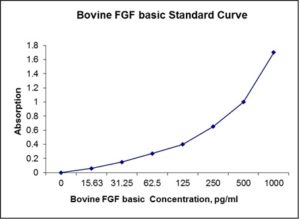Nori Bovine FGFb ELISA Kit
$461.00 – $832.00
This ELISA kit is for quantification of FGFb in bovine. This is a quick ELISA assay that reduces time to 50% compared to the conventional method, and the entire assay only takes 3 hours. This assay employs the quantitative sandwich enzyme immunoassay technique and uses biotin-streptavidin chemistry to improve the performance of the assays. An antibody specific for FGFb has been pre-coated onto a microplate. Standards and samples are pipetted into the wells and any FGFb present is bound by the immobilized antibody. After washing away any unbound substances, a detection antibody specific for FGFb is added to the wells. Following wash to remove any unbound antibody reagent, a detection reagent is added. After intensive wash a substrate solution is added to the wells and color develops in proportion to the amount of FGFb bound in the initial step. The color development is stopped, and the intensity of the color is measured.
Alternative names for FGFb: Basic fibroblast growth factor, bFGF, FGF2 or FGF-β
This product is for laboratory research use only not for diagnostic and therapeutic purposes or any other purposes.
- Description
- How Elisa Works
- Product Citation (25)
- Reviews (0)
Description
Nori Bovine FGFb ELISA Kit Summary
Alternative names for FGFb: Basic fibroblast growth factor, bFGF, FGF2 or FGF-β
Alternative name for bovine: cattle, cow, bull
| Assay Type | Solid Phase Sandwich ELISA |
| Format | 96-well Microplate or 96-Well Strip Microplate |
| Method of Detection | Colorimetric |
| Number of Targets Detected | 1 |
| Target Antigen Accession Number | P03969 |
| Assay Length | 3 hours |
| Quantitative/Semiquantitative | Quantitative |
| Sample Type | Plasma, Serum, Cell Culture, Urine, Cell/Tissue Lysates, Synovial Fluid, BAL, |
| Recommended Sample Dilution (Plasma/Serum) | No dilution for sample <ULOQ; sufficient dilution for samples >ULOQ |
| Sensitivity | 3 pg/mL |
| Detection Range | 15.6-1000 pg/mL |
| Specificity | Bovine FGFb |
| Cross-Reactivity | < 0.5% cross-reactivity observed with available related molecules, < 50% cross-species reactivity observed with species tested. |
| Interference | No significant interference observed with available related molecules |
| Storage/Stability | 4 ºC for up to 6 months |
| Usage | For Laboratory Research Use Only. Not for diagnostic or therapeutic use. |
| Additional Notes | The kit allows for use in multiple experiments. |
Standard Curve
Kit Components
1. Pre-coated 96-well Microplate
2. Biotinylated Detection Antibody
3. Streptavidin-HRP Conjugate
4. Lyophilized Standards
5. TMB One-Step Substrate
6. Stop Solution
7. 20 x PBS
8. Assay Buffer
Other Materials Required but not Provided:
1. Microplate Reader capable of measuring absorption at 450 nm
2. Log-log graph paper or computer and software for ELISA data analysis
3. Precision pipettes (1-1000 µl)
4. Multi-channel pipettes (300 µl)
5. Distilled or deionized water
Protocol Outline
1. Prepare all reagents, samples and standards as instructed in the datasheet.
2. Add 100 µl of Standard or samples to each well and incubate 1 h at RT.
3. Add 100 µl of Working Detection Antibody to each well and incubate 1 h at RT.
4. Add 100 µl of Working Streptavidin-HRP to each well and incubate 20 min at RT.
5. Add 100 µl of Substrate to each well and incubate 5-30 min at RT.
6. Add 50 µl of Stop Solution to each well and read at 450 nm immediately.
Background:
Basic fibroblast growth factor, also known as bFGF, FGF2 or FGF-β, is a member of the fibroblast growth factor family (1). In normal tissue, basic fibroblast growth factor is present in basement membranes and in the subendothelial extracellular matrix of blood vessels. It stays membrane-bound as long as there is no signal peptide. It has been hypothesized that, during both wound healing of normal tissues and tumor development, the action of heparan sulfate-degrading enzymes activates bFGF, thus mediating the formation of new blood vessels, a process known as angiogenesis. bFGF has been shown in preliminary animal studies to protect the heart from injury associated with a heart attack, reducing tissue death and promoting improved function after reperfusion (2). Recent evidence has shown that low levels of FGF2 play a key role in the incidence of excessive anxiety. Basic fibroblast growth factor has been shown to interact with casein kinase 2, alpha 1(3), RPL6 (4) and ribosomal protein S19 (5).
References
- Kim HS (1998). Cytogenet. Cell Genet. 83 (1-2): 73.
- House SL, et al. (2003). Circulation 108 (1): 3140.
- Skjerpen, et al. EMBO J. (England) 21 (15): 4058.
- Shen, B, et al. Biochem. Biophys. Res. Commun. (UNITED STATES) 252 (2): 524.
- Soulet, F, et al. Biochem. Biophys. Res. Commun. (United States) 289 (2): 591.
Be the first to review “Nori Bovine FGFb ELISA Kit”
You must be logged in to post a review.





























Reviews
There are no reviews yet.